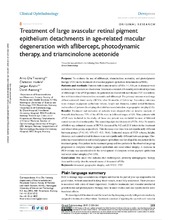| dc.contributor.author | Tvenning, Arnt-Ole | en_US |
| dc.contributor.author | Hedels, Christian | en_US |
| dc.contributor.author | Krohn, Jørgen Gitlesen | en_US |
| dc.contributor.author | Austeng, Dordi | en_US |
| dc.date.accessioned | 2019-06-07T14:05:28Z | |
| dc.date.available | 2019-06-07T14:05:28Z | |
| dc.date.issued | 2019-02-01 | |
| dc.Published | Tvenning A, Hedels C, Krohn J, Austeng D. Treatment of large avascular retinal pigment epithelium detachments in age-related macular degeneration with aflibercept, photodynamic therapy, and triamcinolone acetonide.. Clinical Ophthalmology. 2019;13:233-241 | eng |
| dc.identifier.issn | 1177-5483 | |
| dc.identifier.issn | 1177-5467 | |
| dc.identifier.uri | https://hdl.handle.net/1956/19924 | |
| dc.description.abstract | Purpose: To evaluate the use of aflibercept, triamcinolone acetonide, and photodynamic therapy (PDT) in the treatment of avascular pigment epithelium detachments (aPEDs). Patients and methods: Patients with treatment-naïve aPEDs ≥1,500 µm in diameter were randomized to treatment or observation. Treatment consisted of 6 monthly intravitreal injections of aflibercept. If the aPED persisted, the patients were treated with half-fluence PDT in combination with intravitreal triamcinolone acetonide and aflibercept. The primary outcome was change of best-corrected visual acuity (BCVA) after 24 months of follow-up. Secondary outcomes were changes in pigment epithelium volume, height and diameter, central retinal thickness, and number of patients developing choroidal neovascularization or geographic atrophy (GA). Results: Treatment and inclusion of patients were stopped after an interim analysis of 6-month data because 75% of the aPEDs were in different stages of GA. Nine patients with aPED were included in the study, of these one patient was excluded because of bilateral central serous chorioretinopathy. The remaining eight had drusenoid aPEDs. After 24 months of follow-up, estimated means of BCVA decreased by 4.2 and 20.8 letters in the treatment and observation group, respectively. This decrease over time was not significantly different between groups (P=0.140, 95% CI -5.3, 38.6). Estimated means of PED volume, height, diameter, and central retinal thickness were not significantly different between groups. Choroidal neovascularization and retinal pigment epithelium tear developed in one patient in the treatment group. One patient in the treatment group and two patients in the observation group progressed to complete retinal pigment epithelium and outer retinal atrophy. A decrease in PED volume was associated with the development of complete retinal pigment epithelium and outer retinal atrophy (P=0.029). Conclusion: This small trial indicates that multitargeted, primarily antiangiogenic therapy does not favorably alter the natural course of drusenoid aPEDs. | en_US |
| dc.language.iso | eng | eng |
| dc.publisher | Dovepress | eng |
| dc.relation.uri | https://www.dovepress.com/treatment-of-large-avascular-retinal-pigment-epithelium-detachments-in-peer-reviewed-article-OPTH | |
| dc.rights | Attribution CC BY | eng |
| dc.rights.uri | https://creativecommons.org/licenses/by-nc/3.0/ | eng |
| dc.subject | drusenoid | eng |
| dc.subject | geographic atrophy | eng |
| dc.subject | anti-VEGF | eng |
| dc.subject | PDT | eng |
| dc.title | Treatment of large avascular retinal pigment epithelium detachments in age-related macular degeneration with aflibercept, photodynamic therapy, and triamcinolone acetonide. | en_US |
| dc.type | Peer reviewed | |
| dc.type | Journal article | |
| dc.date.updated | 2019-03-02T14:36:18Z | |
| dc.description.version | publishedVersion | en_US |
| dc.rights.holder | Copyright 2019 Tvenning et al. | |
| dc.identifier.doi | https://doi.org/10.2147/opth.s188315 | |
| dc.identifier.cristin | 1681905 | |
| dc.source.journal | Clinical Ophthalmology | |
| dc.relation.project | ExtraStiftelsen: 2016/FO80635 | |

